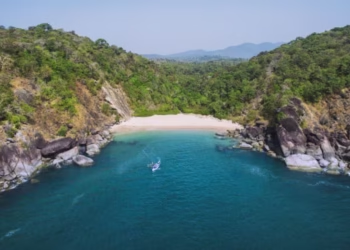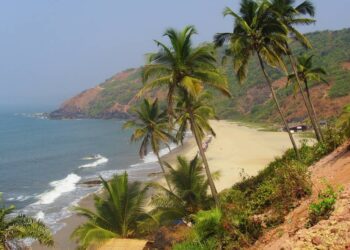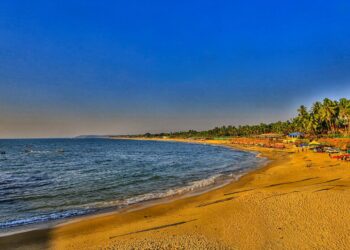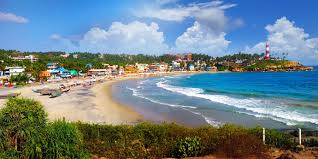Tucked away by the quiet Gomti River in Dwarka, Gujarat, the Dwarkadhish Temple is a sacred place of worship dedicated to Lord Krishna, known here as Dwarkadhish, the King of Dwarka. This old temple, built in the 16th century, is part of the Char Dham pilgrimage and has beautiful carvings and a tall spire that catches the eye. If you want to visit this special spot, here’s a plain guide about its story, what it looks like, its prayers, and how to get there.
Fun Fact: The temple’s flag gets changed five times a day, and it’s a holy offering from people who love Krishna.
Mythological Importance
The Dwarkadhish Temple has old stories. One tale says Lord Krishna made Dwarka his home after leaving Mathura and built this temple to be its king. Another story tells of Lord Vishnu showing up here to bless sage Durvasa, who sat praying by the Gomti River. Locals around here say praying at this temple can free you from sins and make your wishes come true. The temple is a Pushtimarg temple, which means that it follows the teachings and rituals of Vallabhacharya, a 15th-century Hindu saint and philosopher. Vallabhacharya propounded the philosophy of Shuddhadvaita, or pure non-dualism, which emphasizes the devotion and grace of Krishna. The temple is managed by the descendants of Vallabhacharya, who are known as Vallabha Kul.
Historical Overview
The present temple got built in the 16th century by the Vaghela kings, but the temple has existed for more than 2000 years. Dwarka’s an ancient town, a holy place for the Yadava people. Some stone writings from 800 CE point to an even older temple. Back in the 13th century, Chalukya kings added some rooms. In the 1700s, Maratha rulers fixed up the spire. By the 1800s, lots of pilgrims were coming. After 1947, Gujarat’s government took over. Now the Endowments Department looks after it. Around 2000, they fixed it up but kept its old look. Holy men like Adi Shankaracharya, who stopped by in the 8th century, told everyone about it. Today, thousands visit Dwarka’s shores to see it.
The temple’s got a long past. Ruins under the sea near Dwarka make people think of Krishna’s old city. British folks in the 1900s wrote about how grand it was. New finds of carvings from 1200 CE show how old it really is.
Architecture of Dwarkadhish Temple
The Dwarkadhish Temple sits on 5 acres right by the Gomti River, built in the Nagara style. The main part, from the 16th century, has a five-story spire with carvings of Krishna’s flute, his chakra wheel, and peacocks, all done in limestone. Inside the main room, there’s the Dwarkadhish idol—a 2-foot black stone statue of Krishna with four arms, holding a conch shell and a lotus flower. The idol’s dressed in silk and looks bright under oil lamps. The walls inside have old carvings of Krishna’s stories, a bit worn but still there.
There’s a big hall with 60 pillars, each one carved with lotus flowers. In the courtyard, you’ll find smaller shrines for Radha, Lakshmi, and Hanuman, all made of limestone. The Radha shrine, from around 1400 CE, shows her with a flute. The Lakshmi shrine has her with lotus flowers, for good fortune. The Hanuman shrine shows him kneeling, for power. The courtyard’s got stone floors and feels holy, with banyan trees giving shade. A tall 80-foot pole holds the temple’s flag, which gets changed every day. The low walls around have little spots for small gods, like Garuda, who’s said to protect the place. Carvings on the pillars tell about Krishna’s young days, teaching folks who visit. There’s also a ghat by the river with steps where people take holy baths.
Rituals and Festivals
The temple’s full of life with its festivals. Janmashtami, in August, is the biggest, with people singing songs and acting out Krishna’s birth. Tulsi Vivah, in November, is about Krishna’s wedding, with lamps and sweets all around. Every Ekadashi day, which comes once a month, has fasting and prayers for Vishnu. Makar Sankranti, in January, brings rice offerings for good times ahead. Holi, in March, turns the courtyard colorful with music and fun.
Every day, the temple has its routines. At dawn, they do Mangla aarti to wake the idol, then Abhishekam, pouring milk and water. At night, Sandhya aarti with lamps closes the day. Special prayers, like Sudarshana Homam, cost ₹200-1000 and bring blessings. A stall gives out free laddoos as prasad. On Tuesdays, people offer tulsi leaves to Krishna for calm and peace.
During Janmashtami, Garba dances fill the courtyard with cheer. The Gomti ghat, where folks believe bathing cleanses sins, gets busy with pilgrims during festivals.
Information for Travelers
Hours and Entry: Open every day, 6:00 AM to 1:00 PM, then 5:00 PM to 9:30 PM. It’s free to enter, but prayers cost ₹200-1000. You can take pictures outside but not in the main room.
Clothing: Wear clothes that cover your shoulders and knees. Men doing rituals wear dhotis, sometimes with no shirt.
How to Get There:
Air: Jamnagar Airport’s the closest, 130 km away. Taxis take 2.5 hours and cost ₹2500-3500.
Train: Dwarka Railway Station, just 2 km away, connects to Ahmedabad (8 hours) or Mumbai (14 hours). Autos cost ₹50-100.
Road: Buses from Ahmedabad (7 hours) or Rajkot (4 hours) come to Dwarka. Taxis cost ₹2000-3000. The drive by the coast is pretty.
Places to Stay: Dwarka’s got guesthouses like Hotel Gomti (₹1000-2000). Fancier spots like Dwarkadhish Lords Eco Inn cost ₹3000-5000. Stalls near the temple sell vada pav, khakhra, and tea.
Best Time to Visit: October to March is nice, with temperatures around 20-30°C. Weekdays are quieter. Janmashtami gets packed, so book ahead.
Nearby Attractions:
Rukmini Temple, 2 km away, is for Krishna’s wife.
Gomti Ghat, 1 km away, is a holy bathing spot.
Nageshwar Jyotirlinga, 15 km away, is a Shiva temple.
Bet Dwarka, 30 km by ferry, is Krishna’s island home.
Sudama Setu, 3 km away, is a nice bridge to walk.











